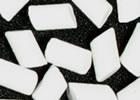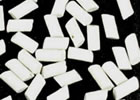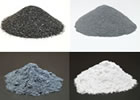Leopard Skin Tumbling Rough
Some call it "leopard skin jasper". We believe it is a mineralized rhyolite.
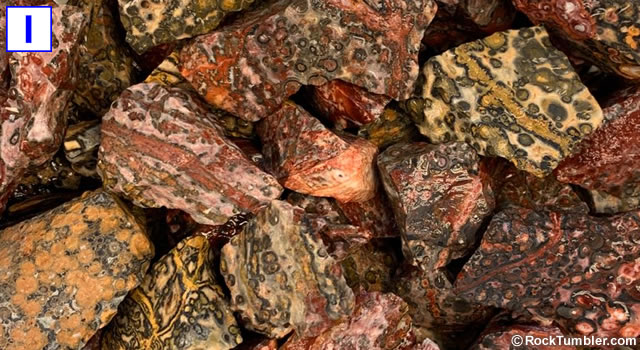
This image shows several pieces of leopard skin rough. These pieces were dumped into a colander and sprayed with water to reveal their true color.
The pieces range between 1/2 inch and 1 1/2 inches in size.
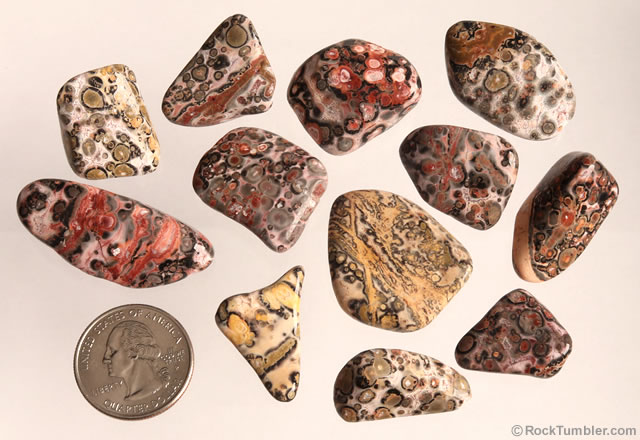
Here are some pieces of leopard skin that we tumbled using the Rock Tumbling Recipe below.
Please note that leopard skin polishes to a soft glow, or a matte finish. It does not polish to a super-bright vitreous luster like agate or jasper.
Leopard Skin Tumbling Rough
 ,
,  , and
, and  What do they mean?
What do they mean?
Size: mostly 1/2 to 1 1/2 inch pieces
If you like tumbled stones with a colorful and interesting appearance, then you'll probably enjoy "leopard skin" tumbling rough. It produces tumbled stones marked with spots, bands, and swirls of color. But the most interesting features are the spots - and the spots are why this material is called "leopard skin". Leopard skin has round spots, ovoid spots, concentric spots, radial spots and much more.
Most of the leopard skin that you receive will have these color patterns: 1) reds, blacks, grays, and whites on a pinkish background; and, 2) golds, tans, browns, blacks, and grays on a tan to cream background. If you are a curious person, get a magnifying device to get a much closer look at your stones. There are many features in these stones that will surprise you.
When polished, leopard skin usually produces a soft glow to a matte finish. It does not produce a bright vitreous luster like jasper or agate. Tumbling it in the polishing step for twice as much time will not significantly improve the luster. In fact, it may reduce the quality of the polish because the surfaces of the stones suffer from the extra impacts of longer tumbling.
Although lots of people call this material "Leopard Skin Jasper", that name is incorrect. Leopard Skin is not a jasper. "Leopard Skin Stone" or simply "Leopard Skin" is more appropriate.
What is this stuff? It is a rock composed of many different minerals. We believe that leopard skin was once a rhyolite. We think the rhyolite was modified by hydrothermal metamorphism - and during that process, hot waters dissolved original minerals, deposited new minerals, and the end result is the leopard-patterned appearance that we see today.
SOME TIPS BEFORE TUMBLING LEOPARD SKIN
Leopard Skin (1/2 to 1 1/2 inch pieces)
When tumbling leopard skin, these things should be considered:
1) Leopard Skin Shapes Quickly:
The minerals that make up Leopard Skin have a Mohs Hardness between 5 and 7. It shapes quickly. We tumble it seven days in coarse grit (four tablespoons per pound of rock+media) and enough water to cover the stones. Even in a small tumbler barrel such as the Thumler's A-R1, A-R2, or MP-1, seven days is usually enough to produce nicely rounded stones. Don't tumble longer or your stones will be reduced in size.
Seven days in medium grit and seven days in fine grit will be long enough. We use four tablespoons of grit per pound of rock+media and add enough water to just cover the stones.
2) Media Is Not Required, But Helpful:
In the coarse grit step, we use about 90% rock and about 10% ceramic media (mixed sizes) to help the stones tumble better. If you don't use media, you will still get nice tumbled stones.
The coarse grit step will reduce the stones in size. When loading the barrel for medium and fine grit, we add the rocks first, then add enough ceramic media (mixed sizes) to get the barrel up to about 1/2 to 2/3 full. This assures that the stones will be tumbled gently.
3) Leopard Skin Does Not Polish to a Super-bright Luster
We always run leopard skin in TXP polish for about 7 to 9 days. An extra day or two in the polishing step might produce a slightly better finish. Leopard skin does not produce an extremely bright luster. It will usually have a matte to subvitreous luster. Polishing it for twice as long will not improve the results.
Recipe for Rotary Tumbling:
Leopard Skin: 1/2" - 1 1/2" Pieces
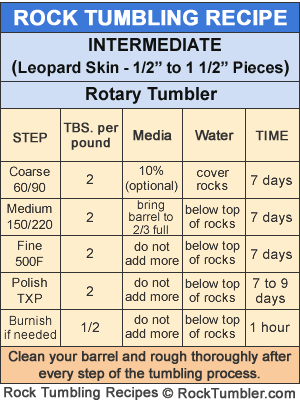
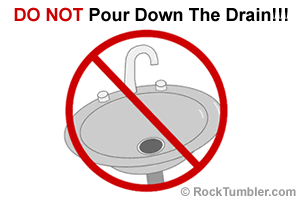
Barrel slurry dumped down the drain will harden like concrete.
Fill the barrel about 2/3 full with a mix of 90% leopard skin and 10% ceramic media. Media is not required for successfully tumbling leopard skin, but we use a small amount to obtain a smoother tumbling action. Then add two level tablespoons of coarse grit per pound of material (rock+media) and cover the rocks completely with water. Then tumble for seven days - or long enough to shape and smooth the stones.
Medium Grit and Fine Grit Steps:
Your rough volume will have dropped because of loss during the previous tumbling step. If you have media, add some to bring the barrel up to about 2/3 full. Use two level tablespoons of grit per pound of material for each of these steps. Add enough water to almost cover the rocks and tumble for one week.
Polish Step:
Be sure that the rocks, media, barrel and lid are extra clean. Also, make sure that the barrel is filled to the proper level. Add more media if needed, but be sure it is clean POLISHED media. Dusty media or media that has not been broken in and smoothed can scratch up your tumbled stones at this step. We use two level tablespoons of TXP aluminum polish for each pound of rock + media in the barrel. Add water until it almost covers the rocks, and tumble for seven to nine days.
Burnish If Needed:
Leopard Skin usually does not improve with burnishing, but if you would like to do a test to see if burnishing might help, you can find information on how to do it in our burnishing article. If you burnish, use 1/2 level tablespoon of grated Ivory Soap per pound of rocks + media in the barrel. Our burnishing article can be found here.
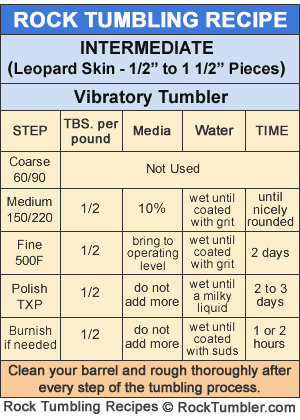
Recipe for Vibratory Tumbling:
Leopard Skin: 1/2" - 1 1/2" Pieces
Coarse Grit (60/90 Mesh) Step:
Coarse grit is not used in a vibrating rock tumbler.
Medium Grit (150/220 Mesh) Step:
We start with a mix of 90% Leopard Skin and 10% ceramic media of mixed sizes. This small amount of media will help the rocks tumble smoothly.
After you have your bowl loaded to the manufacturer's recommended level, add 1/2 tablespoon of grit for every pound of material in the bowl (rocks+media). Turn the tumbler on and while it is running, slowly add water with a spoon or a spray bottle, until the rough and media have a thin coat of wet grit, and the tumbling action is smooth and fast in the bowl.
Check the bowl every 8-12 hours to ensure the action is still good. If the action has slowed, add water a little at a time until the action is back to normal. If the mud gets too thick, you will need to do a complete rinse of the material and bowl. After rinsing, add fresh grit and water and start tumbling again.
How long to tumble? You are done with medium grit when you are satisfied with the shape and smoothness of the stones. We usually spend three to six days with leopard skin. Give the material and bowl (including the lid pad) a thorough cleaning before moving on to fine grit.
Fine Grit (500F Mesh) Step:
Place your material back in the tumbler bowl, then add enough polished ceramic media to bring the load up to the manufacturer's recommended operating level. Add 1/2 tablespoon of grit for every pound of material in the bowl (rock+media). Then, turn the tumbler on and slowly add water until the material has a thin coat of wet grit and the tumbling action is smooth and fast in the bowl.
Open the bowl every 8-12 hours to check the action is still good. We usually run fine grit for 48 hours. Thoroughly clean the bowl, lid pad, and material before moving to the polishing step.
Polishing Step (we use TXP):
Place the cleaned material back in the bowl. Add 1/2 tablespoon of polish for every pound of material in the bowl (rock+media). Turn on the tumbler and slowly add water. Stop adding water when the material has a thin coat of wet polish and the tumbling action is smooth and rapid. The coating of polish should be milky and stick to the rocks.
Like the previous grit steps, open the bowl every 8-12 hours to check the tumbling action. Add water if it has slowed. We have found that 48 hours to 72 hours is usually all the time you need to get a good polish on leopard skin in a vibratory tumbler. Any more time than that and you run the risk of damaging / bruising the material.
Burnish If Needed:
This rough will usually not need burnishing. However, burnishing sometimes improves the look of the finished stones. If you would like to try burnishing to see if it improves the look of your polished stones, full burnishing instructions can be found here.
Tumbled Leopard Skin Is Available
We usually have medium-size (5/8" to 1") tumbled stones of leopard skin for sale to anyone who would rather purchase finished stones than run a tumbler. You can find them here.
Customers also bought...
Large Ceramic Media

Small Ceramic Media

Standard Grit Kit



